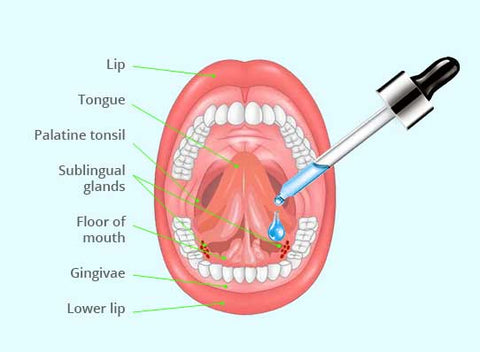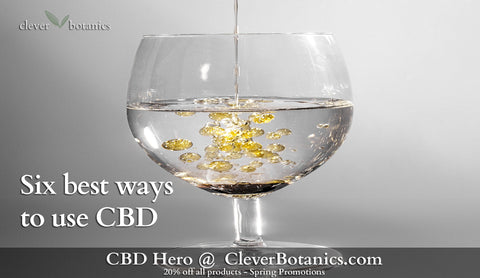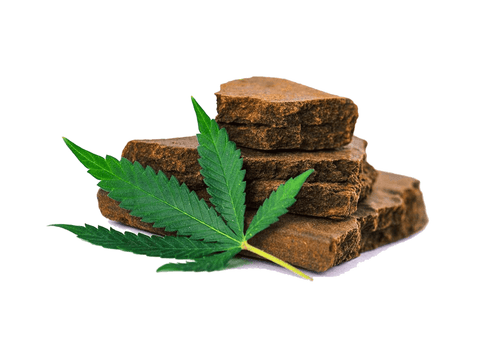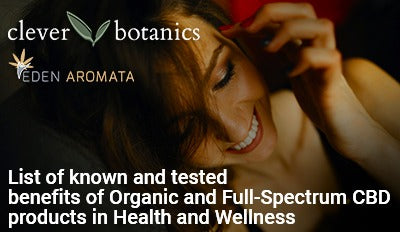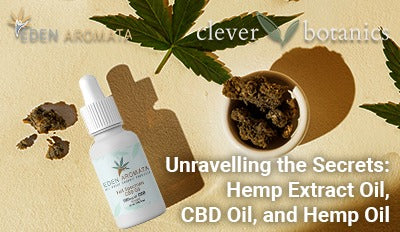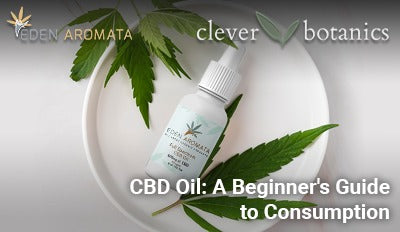Methods of Consuming CBD products and what to look out for
I am continually being asked @CleverBotanics to explain the best method of consuming the CBD products we sell. I hope this blog helps to bring some clarity to this area.
The current lack of transparency in this industry is a direct result of a lack of regulation. Producers know how to potentially manipulate the numbers quoted on the products they sell and scam their buyers as a result.
A few months ago at a CBD exhibition, I noticed the questionable approach in promoting their CBD Oil by a nameless supplier with probably the biggest stand and matching big 4-page advert in the conference booklet. The company did not mention how many mg of CBD was contained in their bottle or the packaging. The statement was that it was a 30ml bottle of CBD Oil. (It is not illegal for them to take 10 ml and dilute it into 30 ml bottles). The small print on the box stated it contained 500mg of Cannabidiol, but when I asked for the lab report, I noticed that clearly the bottle had only a total of 63mg of CBD. The 500 mg statement on the bottle, simply didn't compute. In fact, the maths added up to no more than 65mg in reality. Yet the user will think they are getting a fantastic deal by buying 30ml, which is a big bottle at a bargain price! You really have to check the details of everything to ensure the product you are buying hasn't been diluted and always ask for the lab report as that never lies.
To make things worse, this supplier suggested in very small print that I needed a magnifying glass to read, that 5mg of CBD would be an acceptable daily dosage. In reality, a reputable company should always suggest 20-50 mg will render any effects, depending on the method of consumption. And the process dictates the bioavailability of the product and how CBD enters the bloodstream.
Assuming that the manufacturer is honest and told you exactly how much CBD there is in their bottle and what dose you really need, there is another critical consideration; BioAvailability. CBD is available in many various forms including Topicals, Tinctures, Oils, E-liquids, Capsules, Chocolate and many more. Each of these different formats requires a different usage method, and each product as we have learnt earlier, comes in multiple concentrations of CBD. Bioavailability is basically, the degree and rate at which a substance is absorbed into the bloodstream.
So what is the best way?
Medically speaking intravenous administration is the best. But I don't think anyone will consider that approach for obvious reasons! :)

Oral consumption
The easiest method if you can accept the taste of the product. But a 1986 study reported a very low bioavailability rate near enough to 6%. Another 2009 study reported it to be between 4% and 20%. While both findings differ significantly, both are pretty low, with a 20% bioavailability rate being the most optimistic scenario. And probably combined with careful preparation of the product and mixing it with other oily products like coconut oil or milk.
Theoretically, a Chocolate that states it has 50mg of CBD contained in it will only release 10mg of CBD into your bloodstream.
Sublingual Consumption
The under the tongue method is well known, as there is a vein called the sublingual gland there to aid absorption. When the product in the form of Oil or other is dropped or sprayed on to the sublingual gland, it gets absorbed directly into the bloodstream. Conventional sublingual consumption methods include CBD tinctures, oil and CBD sprays gummies. The reported rates range from 15% - 35% and the longer one keeps the product under the tongue for full dispersion, the better the rate of absorption.
Vaping or Smoking
Taking CBD products or hemp flowers directly into the lungs by smoking or vaping with a vaporizer device may not be the cleanest approach, but it most certainly provides the highest bioavailability of 34% - 56% according to reports. Inhaling CBD has potentially up to a 5x higher bioavailability than oral ingestion thanks to the large, highly permeable surface of the interior of the lungs. Inhaling also has a consistently quick onset in only a few minutes. Inhaling CBD has a faster onset with a shorter period of effectiveness. However, vaping has not had enough time for science to determine that it is an absolutely safe method or not. A much longer track record of 15-20 years is needed to make a reliable safety statements.
This year we do see from various published data that Inhaling CBD is indeed becoming one of the most popular methods of consuming the substance thanks to it's quick time to onset and high effectiveness. Today there are a growing number of products available including CBD-specific vape products, hemp flower, and concentrates used for dabbing.

Carrier Oils
Cannabinoids, including CBD, are fat-soluble and break down to be stored in fat. Generally, CBD is not water-soluble; however, when they are consumed with fat, the compounds can be more effectively ingested by the body and enter the bloodstream. For this reason, many products utilize an oil carrier that mixed with the hemp and cannabis extracts.
MCT oil is the most commonly used carrier for the majority of the products out there, and our body burns these fats and puts them, and the cannabinoids they hold to use more effectively.
The combination of the CBD and oil as the carrier can produce a marginal increase in the overall amount of CBD, and other cannabinoids absorption by the body and therefore, result in better bioavailability.
Products utilizing this method are commonly called oil-based. They are low cost, easy to make, and have dominated the early years of the hemp market. The downside is these products don't increase bioavailability much, maybe only a few percents.
Topical administration
Administering cannabidiold by lotions, balms, salves & patches directly to the skin is another popular way to utilize hemp extracts. There are a wide variety of lotions, balms, and salves available to serve this need. These products are designed to alleviate symptoms, including aches and skin issues. This method of application is viable because there are cannabinoid receptors found in the skin.
CBD Suppository
This is most certainly the least popular method of administering CBD into the body. However, suppositories are proven to be highly bioavailable and thus, a highly effective means of using CBD. Using a CBD suppository has the best of both worlds when it comes to onset and length of effects. These will show noticeable effects after less than 15 minutes, and the results can last for nearly 8 hours - longer than all other forms of taking CBD. However, at this moment in time, these products are best sold via Chemists and physicians that can provide support to users that are uncomfortable with its use.
Summary
Question most asked in many forums is "How do I know if it is working?" Depending on one's condition and specific requirements, it can be difficult to tell whether or not a product is working right away. Idealy some experimentation with quantity and dosing is good. If you have medical conditions, then please do always consult a healthcare professional before using CBD based products or replacing the doses with any other prescribed therapy or medication. It is advisable to start with a low dose and gradually increase the amount may prove fruitful, especially for oral products with low bioavailability. If at all possible then chose "Full spectrum" CBD products, unlike isolates which solely contain CBD, the range of Canibiods available in the full spectrum product may result in greater therapeutic value, because many other cannabinoids and terpenes work together. If, however, you don’t want to consume any amount of THC, which has psychoactive effects, you may also try broad-spectrum products. By using products with other cannabinoids, you are more likely to get the full impact of your CBD and feel the product working.
There are other potential reasons for a product not delivering the promised effect that is mostly from crowdsourced data.
Is your product from a reputable source and do they have decent third-party lab tests that indicate the actual amount of CBD in the product.
Let the CBD build up in your body for some time, and the individual's requirement for a daily dose varies with numerous variables such as person's weight, condition, age, and other health factors. In a complex scenario, it is best to consult your doctor before consumption.
|
Method of Consumption |
Bioavailability |
Onset (Approximate) |
How long will it last |
|
Oil-Based Oral (Capsules, Edibles) |
Lowest |
30-90 Minutes |
Approximately up 8 Hours |
|
Topical (Lotions, Balms, Patches) |
Low |
60-90 Minutes |
Approximately up to 6 Hours |
|
Oil-Based Sublingual (CBDoil, Tinctures, Sprays) |
Low-Mid |
20-40 Minutes |
Approximately up to 6 Hours |
|
Water Soluble Oral (Edibles Capsules) |
Mid-High |
15-45 Minutes |
Approximately up to 5 Hours |
|
Inhalation (Vape, Smoke, Dabbed) |
Mid-High |
2-5 Minutes |
Approximately up to 3 Hours |
|
Water Soluble Sublingual (Tinctures, Sprays) |
High |
10-20 Minutes |
Approximately up to 4 Hours |
|
Suppositories |
Highest |
10-15 Minutes |
Approximately up to 8 Hours |




